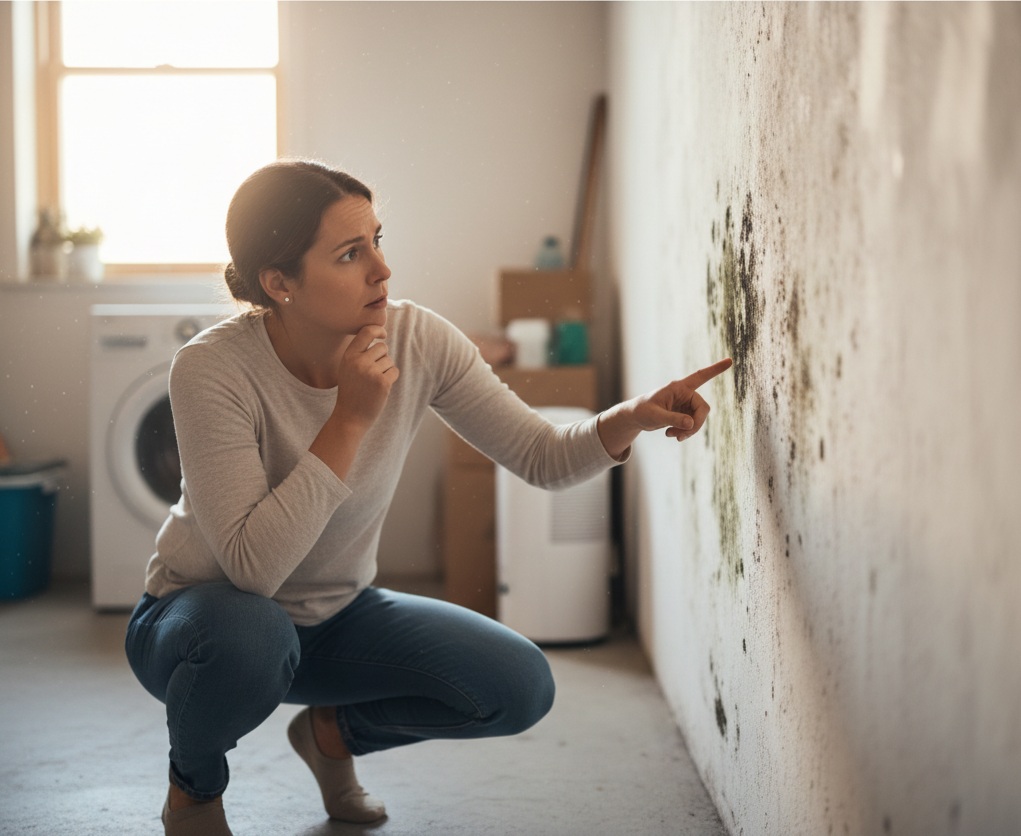Spotting mold in your home can feel stressful. Your mind races with questions: How serious is this? How long will it take to fix? And perhaps most importantly, can you stay in a house with mold being removed, or do you need to pack up and leave?
This is not just about convenience. It is about your family’s health, your daily routine, your pets, and yes, your budget too. Is it safe to stay home during mold removal? The answer is not always straightforward, and that’s exactly why understanding the mold remediation process is so important.
Understanding What Mold Remediation Actually Involves
Before we dive into mold cleanup safety for residents, let’s talk about what the mold remediation process really means. It is not just scrubbing some spots off your wall and calling it a day.
Mold remediation is a systematic process that involves identifying the source of moisture, containing the affected area, removing contaminated materials, cleaning and disinfecting, and then restoring your space. The complexity can vary dramatically based on how extensive the problem is.
A small patch of mold in a bathroom corner is different from significant growth behind your walls or in your HVAC system. This difference matters enormously when deciding whether you should leave your home during mold remediation.
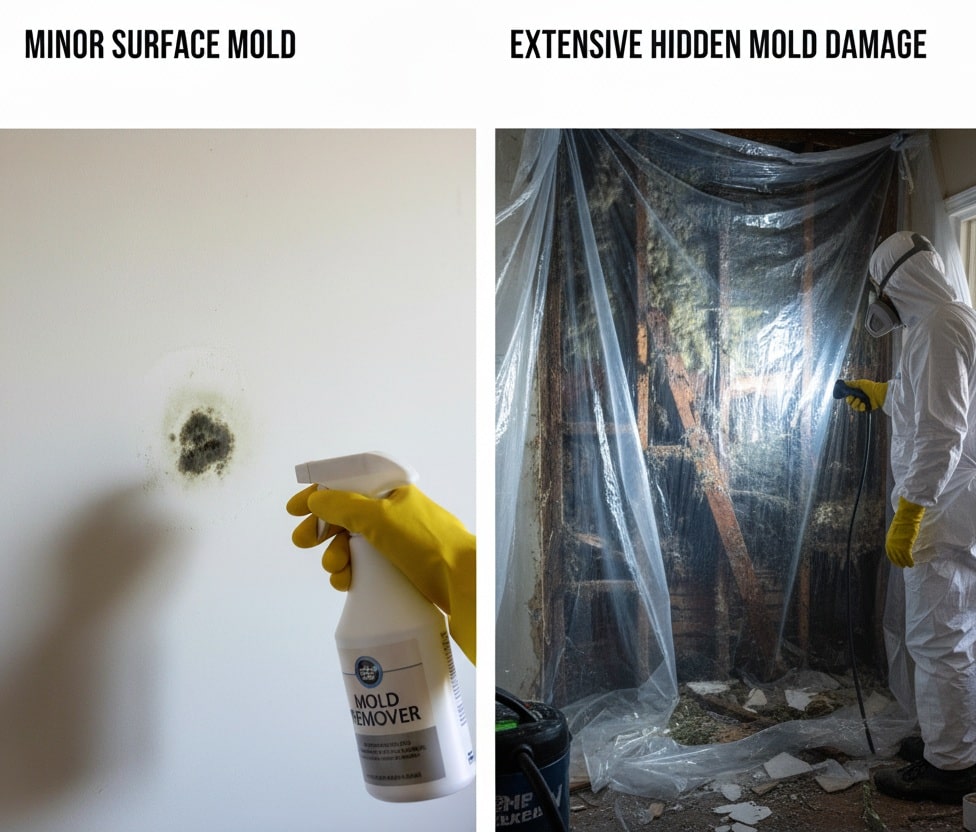
The Size and Scope Factor: Mold Remediation Guidelines for Homeowners
Think of mold remediation like home repairs: replacing a light switch versus rewiring your entire house. The scale guides everything.
For minor mold issues covering less than 10 square feet, professional mold remediation typically takes only a few hours. The affected area gets sealed off with plastic sheets, professionals wear protective gear, and the space is treated while the rest of your home remains relatively undisturbed. In these cases, staying in your home during mold treatment may be acceptable, provided you follow proper mold removal safety precautions.
When mold has spread to multiple rooms, infiltrated your ventilation system, or requires drywall and flooring removal, the situation changes. These large projects can take days or weeks and involve heavy machinery, demolition, and air quality issues. This is when mold removal requires leaving your home.
Effects of Mold Remediation on Indoor Air Quality
Here’s something most people don’t realize until they’re in the middle of it: disturbing mold releases spores into the air. It’s like shaking out a dusty blanket, except these aren’t just dust particles.
During active remediation, especially when removing contaminated materials, spore counts in the air can temporarily increase. This is why understanding the effects of mold remediation on indoor air quality is crucial. Professional remediators use containment barriers, negative air pressure systems, and mold remediation and air filtration systems to prevent these spores from spreading throughout your home. But no containment system is perfect.
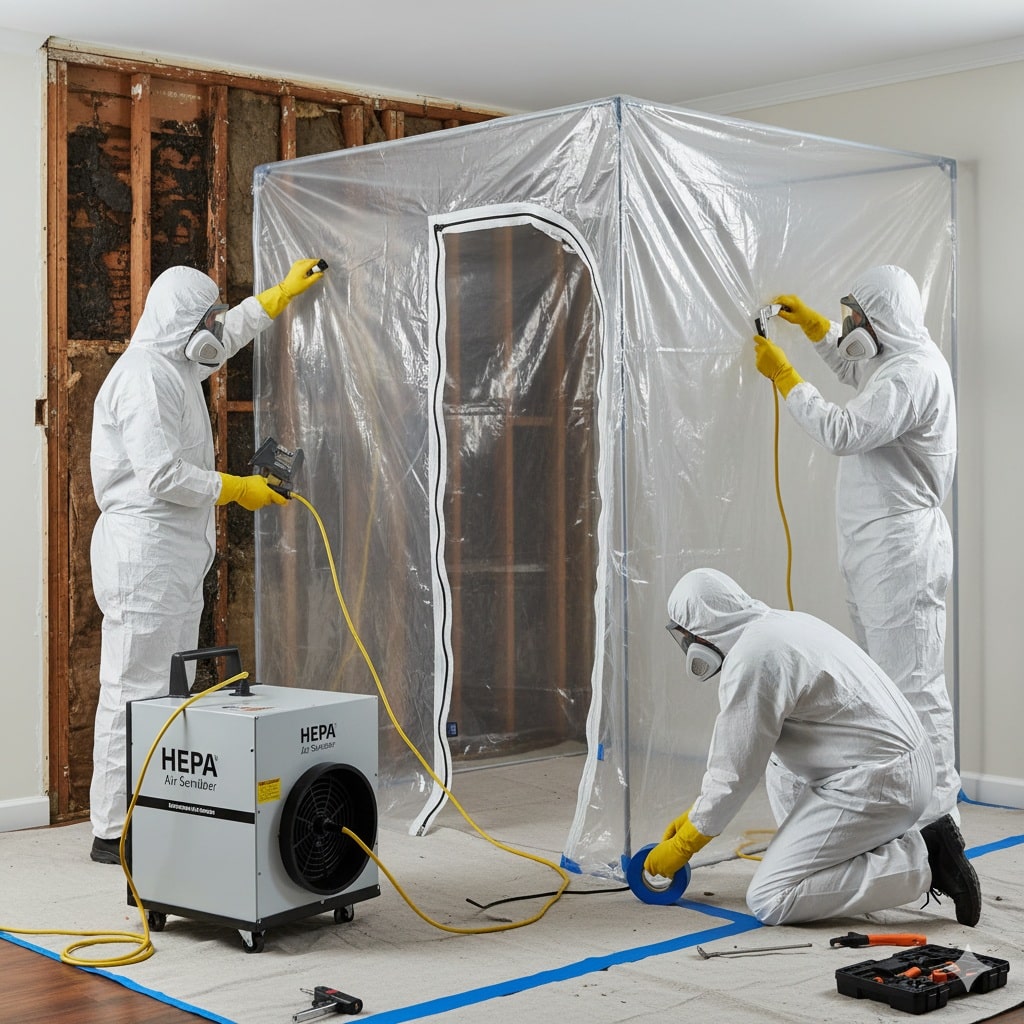
The issue arises: to what level of exposure is it safe, particularly when you may have young children, aged family members, or respiratory sensitivity of any sort? The chance of being exposed to Mold during the remediation is greatly varied according to the scope of the project and the safety of the project on the remediation of the mold.
Mold Cleanup and Health Risks You Should Think About
Your body’s response to mold varies based on several factors. Some people have no reaction whatsoever, while others experience noticeable symptoms even with minimal exposure.
Common reactions to mold exposure include respiratory issues like wheezing, coughing or throat irritation. Some people experience nasal congestion, eye irritation, or skin rashes. Those with asthma or mold allergies often find their symptoms worsen around mold or during remediation activities.
People with compromised immune systems, chronic lung diseases, or mold sensitivities face heightened mold cleanup and health risks. For these individuals, even staying in a home where minor remediation is occurring might not be advisable.
The chemicals used during remediation also deserve consideration. Is mold remediation toxic to your health? While professionals use EPA-approved antimicrobial treatments, biocides, and cleaning agents, these products can produce strong odors and airborne irritants. Sensitivity to these chemicals varies from person to person, which is why mold removal safety precautions are essential.
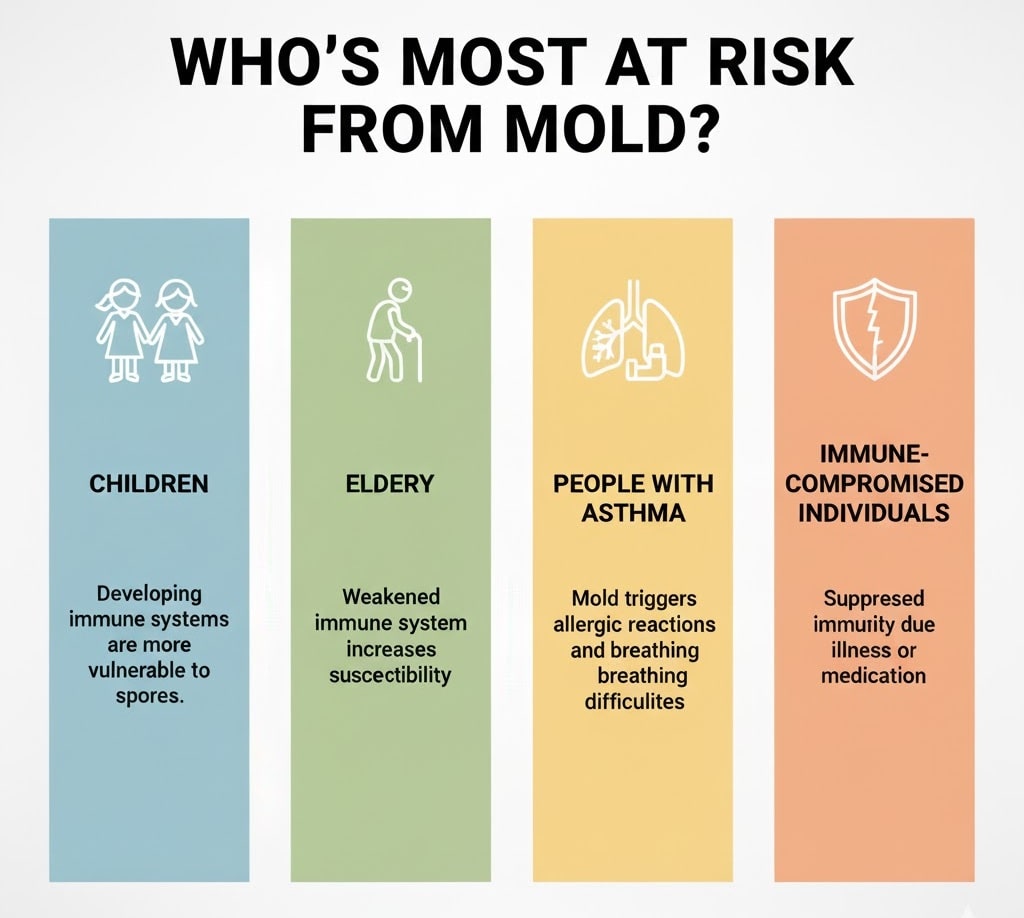
When Staying Home Might Be Reasonable
Let’s discuss situations where mold remediation can occur while you live in the house and becomes a viable option.
If the affected area is small, contained to one room, and that room can be completely sealed off from your living space, staying in the home becomes more feasible. A bathroom with its own ventilation that you can avoid using for a day or two? That might be manageable with proper safety measures during mold remediation.
When professionals can work in an unoccupied basement or attic with its own air circulation, and the work happens during daytime hours when you could spend time elsewhere, you might not need to stay out of home.
Single-room projects that take less than a day, especially if you have somewhere to go during work hours, rarely require a household evacuation. Knowing how long to leave your home during mold remediation helps you plan.
The key is genuine containment. Can the affected area be truly isolated? Does it have separate ventilation? Can you avoid that space entirely during and immediately after treatment?
When Should You Leave Your Home During Mold Abatement?
Some situations make staying in your home during mold treatment genuinely inadvisable.
When mold has invaded your HVAC system, it affects every room. Remediation requires shutting down your heating and cooling, and cleaning duct work sends disturbances throughout your entire home. You can’t really contain air that travels through your ventilation system. This is a clear scenario for when to leave your home during mold removal.
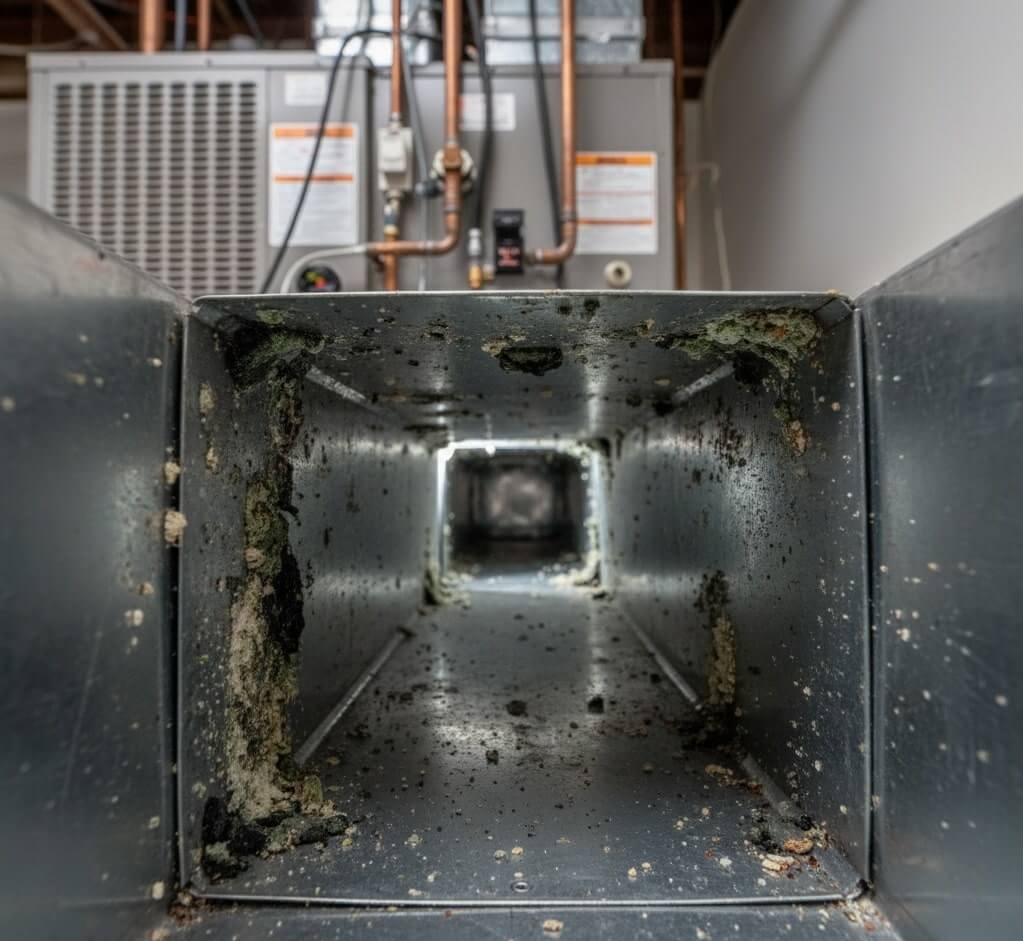
Extensive remediation requiring walls to be opened, flooring removed, or structural materials demolished creates massive disruption. The noise alone would make staying home unpleasant, but the dust, debris, and airborne particles make it potentially unhealthy.
If anyone in your household has serious respiratory issues, immune system concerns, or diagnosed mold allergies, erring on the side of caution makes sense. The temporary inconvenience of staying elsewhere beats risking someone’s health. Should you evacuate your home during mold remediation? In these cases, absolutely yes.
Multiple-room projects spanning several days create cumulative exposure. Even if daily exposure seems minimal, breathing in spores and remediation chemicals for days on end adds up, increasing the risk of exposure to mold during remediation.
What Professional Remediators Typically Recommend
Most certified mold remediation professionals will assess your specific situation and give personalized mold remediation guidelines for homeowners. They consider the extent of contamination, the location of affected areas, the methods they’ll use, and the composition of your household.
Many professionals suggest that at minimum, vulnerable household members should stay elsewhere during active remediation. This includes infants, young children, pregnant women, elderly individuals, and anyone with respiratory or immune concerns. The impact of mold remediation on family members or pets can be significant.
For bigger projects, most professionals recommend the entire household relocate temporarily. This isn’t just about health. It also allows workers to move freely, work more efficiently, and complete the job faster without worrying about disturbing family life.
Some companies won’t even begin work if they know vulnerable individuals will be present during the process. This isn’t them being difficult; it’s them taking your health seriously and following mold cleanup safety protocols for residents.
Preparing Your Home for Mold Removal: The Practical Realities
Beyond health concerns, staying in your home during mold treatment can be genuinely disruptive in ways you might not anticipate.
Preparing your home for mold removal involves more than just clearing the affected area. Water and electricity to affected areas often get shut off. If your bathroom is being remediated, where will you shower? If your kitchen has mold issues, how will you cook?
The noise from air scrubbers, dehumidifiers, and demolition equipment runs continuously. These machines are loud. Think vacuum cleaner running non-stop for hours or days. Working from home, helping kids with homework, or even sleeping becomes challenging.
Your home will smell different. Even with proper containment and mold remediation and air filtration systems, you’ll notice chemical odors from cleaning agents and the musty smell of mold itself becoming more pronounced as materials get disturbed.
Access to certain areas becomes restricted. Plastic barriers, closed doors, and remediation equipment block normal pathways through your home. Your usual routines get interrupted.
Questions to Ask Your Remediation Company
Before work begins, have a detailed conversation with your remediation team. Don’t feel awkward about asking questions.
Ask specifically: “Is it safe to stay home during mold removal?” and “Should you evacuate your home during mold remediation?” Press for their honest professional opinion based on your household composition.
Find out what safety measures during mold remediation they’ll use. How will they prevent spore spread? What kind of air filtration will they employ? How often will they monitor air quality to minimize the effects of mold remediation on indoor air quality?
Understand the timeline. How many days will active work occur? How long to stay out of your home during mold remediation if you do leave? When can you safely return? What cleaning needs to happen before reoccupying treated spaces?
Inquire about air quality testing. Will they test before, during, and after remediation? Can you see the results? What levels indicate safe reoccupation?
Ask about their experience with households that stayed versus left. What did they observe regarding the risk of exposure to mold during remediation? What complications arose? What worked well?
Special Considerations for Renters and Apartment Dwellers
If you’re renting, whether you can stay in a house with mold being removed often isn’t entirely your decision. Landlords and property management companies may have policies about occupancy during remediation work.
In apartment buildings, mold remediation can affect neighboring units even if yours is the only one with visible problems. Containment becomes more critical, and property managers might temporarily relocate multiple residents following mold remediation guidelines for homeowners and renters alike.
Check your lease agreement and local tenant laws. In many places, landlords must provide alternative housing if your unit becomes temporarily uninhabitable due to necessary repairs, including mold remediation.
The Financial Consideration
Let’s be honest, relocating temporarily costs money. Hotels, short-term rentals, eating out more frequently, and the general inconvenience all add up.
This financial pressure makes many homeowners want to stay put. It’s completely understandable to think, “If I can just tough it out for a few days, I’ll save hundreds or thousands of dollars.”
But consider the potential costs of not leaving when you should. Medical bills from respiratory issues, lost work days due to illness, and the possibility of remediation taking longer because workers must work around your schedule can exceed temporary housing costs. The mold cleanup and health risks of staying could far outweigh relocation expenses.
Some homeowners insurance policies cover temporary relocation expenses during remediation if the mold resulted from a covered event like a burst pipe. Review your policy or speak with your insurance agent about what’s covered.
Impact of Mold Remediation on Family Members or Pets
The impact of mold remediation on family members or pets deserves serious consideration. Animals can be affected by mold spores and remediation chemicals just like humans. Dogs and cats with shorter snouts often have more sensitive respiratory systems.
Small pets like birds, rabbits, or reptiles are particularly vulnerable to airborne contaminants and chemical fumes. Their smaller body size means they’re affected more quickly and severely by mold cleanup and health risks.
Fish tanks need special attention. Air pumps draw in room air, potentially introducing spores and chemicals into aquarium water. Covering tanks isn’t enough; the equipment still needs clean air to function.
If remediation is extensive, relocating pets along with family members is often the safest choice. Can mold remediation happen while you live in the house with pets? Only in very limited circumstances with minor projects.
The Aftermath: When Is It Really Safe to Return?
Just because workers pack up doesn’t mean your home is immediately safe to reoccupy. Post-remediation protocols matter for ensuring proper mold cleanup safety for residents.
Professional remediators should conduct final cleaning of the work area, removing all containment materials and HEPA-vacuuming surfaces. They should run air scrubbers for a period after completing physical work to reduce airborne particle counts and improve the effects of mold remediation on indoor air quality.
Many professionals recommend post-remediation air quality testing by an independent inspector (someone not affiliated with the remediation company). This provides unbiased confirmation that spore counts have returned to normal levels.
Your home should be thoroughly ventilated before reoccupation. Opening windows, running fans, and allowing fresh air circulation helps clear any lingering odors or particles. This is part of proper mold removal safety precautions.
Some remediation companies provide documentation specifying how long to stay out of your home during mold remediation. Don’t rush back before receiving this clearance, especially if vulnerable individuals are returning.
Making the Decision That's Right for Your Situation
So, can you stay in a house with mold being removed? The answer genuinely depends on your unique circumstances.
Small, contained projects with proper professional protocols and safety measures during mold remediation might not require leaving. Large-scale remediation affecting multiple rooms or your HVAC system almost always necessitates temporary relocation.
Your household composition matters immensely. Healthy adults might tolerate conditions that would be risky for children, elderly relatives, or people with health concerns. Is mold remediation toxic to your health? It can be, especially for vulnerable populations.
Trust professional recommendations. If your remediation team suggests leaving, they’re not being overly cautious. They’re protecting you based on experience and industry standards for mold cleanup safety, as recommended for residents.
When in doubt, prioritize health over convenience. Should you evacuate your home during mold remediation? The short-term hassle of securing somewhere else to stay beats the long-term consequences of respiratory problems or prolonged mold exposure.
Consider this an opportunity to stay with family or friends, or turn it into a mini-vacation if possible. Reframing temporary displacement helps reduce stress while preparing your home for mold removal.
Document everything. Take photos, keep receipts, maintain communication records with your remediation company. This protects you legally and helps if insurance claims are involved.
Listen to your body. If you choose to stay during minor remediation and start experiencing headaches, respiratory irritation, or unusual fatigue, leave immediately. Your physical response is telling you something important about the risk of exposure to mold during remediation.
The mold remediation process is temporary. Whether you stay or go, the situation will resolve. Making informed decisions based on your specific circumstances, professional guidance, and honest assessment of health risks helps you navigate this challenge safely and emerge with a healthier home.

